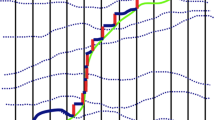Abstract
Most investigations into heart rate dynamics have emphasized continuous functions, whereas the heart beat itself is a discrete event. We present experimental evidence that by considering this quality, the dynamics may be appreciated as a result of singular dynamics arising out of non-Lipschitz formalisms. Markov process analysis demonstrates that heart beats may then be considered in terms of quantum-like constraints.
Similar content being viewed by others
References
Arnold VI (1989) Mathematical models of classical mechanics, 2nd edn. Springer, Berlin Heidelberg New York, pp 4–8
Cohen IB (1971) Introduction to Newton's ‘Principia’. Cambridge University Press, Cambridge
Coddington EA, Levinson N (1955) Theory of ordinary differential equations. McGraw-Hill, New York, pp 8–11
Delcour AH, Lipscombe D, Tsien RW (1993) Multiple modes of N-type calcium channel activity distinguished by differences in gating kinetics. J Neurosci 13:181–184
Earman J (1986) A primer on determinism. Reidel, Dordrecht
Eckmann J-P, Ruelle D (1992) Fundamental limitations for estimating dimensions and Liapunov exponents in dynamical systems. Physica D 56:185–187
Einstein A (1983) Geometry and experience. In: Sidelights on relativity. Dover, New York, pp 27–56
Everitt B (1980) Cluster analysis. Halsted Press, New York
Feller W (1968) An introduction to probability theory and its applications, vol 1. Wiley, New York
Gerstein GL, Mandelbrot B (1964) Random walk models for the spike activity of a single neuron. Biophys J 4:41–68
Ghil M, Vautard R (1991) Interdecadal oscillations and the warming trend in global temperature time series. Nature 350:324–327
Grassberger P, Schreiber T, Schaffrath C (1991) Nonlinear time sequence analysis. Int J Bifurcation Chaos 1:521–547
Haken H (1991) Synergetics:Can it help physiology? In: Haken H, Koepchen H-P (eds) Rhythms in physiological systems. Springer, Berlin Heidelberg New York, pp 21–31
Hübler A (1992) Modeling and control of complex systems: papradigms and applications. In: Lam L, Naroditsky V (eds) Modeling complex phenomena. Springer, Berlin Heidelberg New York, pp 5–65
Kitney RI, Rompelman O (eds) (1987) The beat to beat investigation of cardiovascular function. Clarendon Press, Oxford
Lenzen VF (1954) Causality in natural science. Thomas, Springfield, Ill
Ruelle D (1994) Where can one hope to profitably apply the ideas of chaos? Physics Today 47 [July]:24–30
Sapoznikov D, Luria MH, Gotsman MS (1994) Differentiation of periodic from nonperiodic low-frequency heart rate fluctuations. Comp Biomed Res 27:199–209
Shaw CT, King GP (1992) Using cluster analysis to classify time series. Physica D 58:288–298
Somjen GG (1992) The missing error signal: regulation beyond negative feedback. News Physiol Sci 7:184–185
Stelzel W, Kautzky T, Hübler A, Lüscher E (1988) Über die Eindeutigkeit der Lösungen der Eulerschen Gleichungen in der klassischen Mechanik. Helv Phys Acta 61:224–227
Vautard R, You P, Ghil M (1992) Singular spectrum analysis: a toolkit for short, noisy chaotic signals. Physica D 58:95–126
Webber CL Jr, Zbilut JP (1994) Dynamical assessment of physiological systems and states using recurrence plot strategies. J Appl Physiol 76:965–973
Wiesenfeld K, Moss F (1995) Stochastic resonance and the benefits of noise: from ice ages to crayfish and SQUIDs. Nature 373:33–36
Wilders R (1993) From single channel kinetics to regular beating. Dissertation, University of Amsterdam, Amsterdam, The Netherlands
Wilders R, Jongsma HJ (1993) Beating irregularity of single pacemaker cells isolated from the rabbit sinoatrial node. Biophys J 65:2601–2613
Winfree AT (1990) The geometry of biological time. Springer, Berlin Heidelberg New York
Yates FE (1993) Self-organizing systems: In: Boyd CAR, Noble D (eds) The logic of life. Oxford University Press, Oxford, pp 189–218
Zak M (1970) Uniqueness and stability of the solution of the small perturbation problem of a flexible filament with a free end. PMM (Moscow) 39:1048–1052
Zak M (1983) Cumulative effect at the soil surface due to shear wave propagation. J Appl Mech 50:227–228
Zak M (1993) Introduction to terminal dynamics. Complex Syst 7:59–87
Zak M (1994) Physical models of cognition. Int J Theor Phys 33:113–1161
Zbilut JP (1991) Power laws, transients, attractors and entropy: possible implications for cardiovascular dynamics. In: Haken H, Koepchen H-P (eds) Rhythms in physiological systems. Springer, Berlin Heidelberg New York, pp 139–152
Zbilut JP, Murdock D, Lawson L, Lawless C, Von Dreele M, Porges S (1988) Use of power spectral analysis of respiratory sinus arrhythmia to detect graft rejection. J Heart Transplant 7:280–287
Zbilut JP, Zak M, Webber CL Jr (1994) Nondeterministic chaos approach to neural intelligence. In: Dagli CH, Fernandez B, Ghosh J, Kumara SRT (eds) Intelligent engineering systems through artificial neural networks, vol 4. ASME Press, New York, pp 819–824
Author information
Authors and Affiliations
Rights and permissions
About this article
Cite this article
Giuliani, A., Giudice, P.L., Mancini, A.M. et al. A Markovian formalization of heart rate dynamics evinces a quantum-like hypothesis. Biol. Cybern. 74, 181–187 (1996). https://doi.org/10.1007/BF00204206
Received:
Accepted:
Issue Date:
DOI: https://doi.org/10.1007/BF00204206




